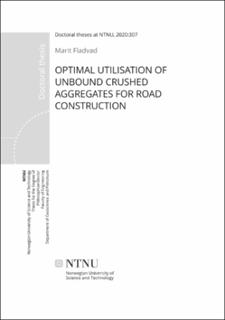| dc.contributor.advisor | Wigum, Børge Johannes | |
| dc.contributor.advisor | Scibilia, Elena | |
| dc.contributor.advisor | Mathisen, Lillian Uthus | |
| dc.contributor.advisor | Kleiv, Rolf Arne | |
| dc.contributor.author | Fladvad, Marit | |
| dc.date.accessioned | 2020-10-12T06:00:56Z | |
| dc.date.available | 2020-10-12T06:00:56Z | |
| dc.date.issued | 2020 | |
| dc.identifier.isbn | 978-82-326-4963-1 | |
| dc.identifier.issn | 1503-8181 | |
| dc.identifier.issn | | |
| dc.identifier.uri | https://hdl.handle.net/11250/2682106 | |
| dc.description.abstract | Aggregates are construction materials produced from non-renewable rock resources. Because high-quality aggregate resources have limited availability, utilisation of aggregates should be considered carefully to prevent resource scarcity. When suitable aggregate resources are encountered at or close to construction sites, e.g. surplus material from tunnelling, they should be utilised in construction rather than landfilled or used for less qualitydemanding purposes. To obtain optimal utilisation, we must ensure that the best possible construction materials are produced from the available resources.
Climate changes are expected to represent a shift towards increased precipitation and more intense rainfall events. This development may cause increased moisture levels in pavement structures, which in turn may affect pavement performance. The Norwegian pavement design system is empirical, and thus not suited for adaptation to new environmental conditions. To adapt the pavement design to changing climatic conditions, the behaviour of typical road materials must be understood.
The research presented in thesis concerns three subjects:
– Use of large-size aggregates in pavement structures
– Production methods affecting aggregate quality
– Influence of aggregate gradation and moisture on pavement performance
A construction practice of using large-size aggregates is uncommon outside the Nordic countries. European standards do not cover large-size aggregates with upper particle size over 90 mm. The main concern regarding the use of large-size aggregates is the lack of suitable quality assessment methods.
The research design focussed on testing large-size aggregates using two full-scale studies. A full-scale crushing test examined the influence of crusher and feed parameters on the quality of primary crushed aggregates. The results showed that through adjustments to the crushing process, product quality measured as gradation and particle shape can be controlled. Optimising mechanical properties requires more than one crushing stage.
An accelerated pavement test investigated the performance of two instrumented pavement structures constructed using large-size subbase aggregates.
The stress and strain response and performance of the unbound pavement materials were modelled using multi-layer elastic theory. Increased moisture content in unbound pavement materials leads to a substantial acceleration of permanent deformations from traffic. The stiffness of the unbound materials decreases as moisture content increases.
The research showed that the utilisation of aggregate resources in pavement structures have a clear potential for increase without compromising longterm pavement performance. There is room for optimisation of aggregate utilisation even within current quality requirements.
Adapting pavement structures to future climate changes leads to a more reliable and resilient transport infrastructure. Making efforts for optimal utilisation of available aggregate resources will reduce the consumption of non-renewable resources. By using more local resources, aggregate transport can be reduced, which will reduce the carbon footprint of the construction projects. Combined, these effects will help ensure a more sustainable infrastructure development. | en_US |
| dc.language.iso | eng | en_US |
| dc.publisher | NTNU | en_US |
| dc.relation.haspart | Paper A: Fladvad, Marit; Aurstad, Joralf; Wigum, Børge Johannes. Comparison of practice for aggregate use in road construction — results from an international survey. I: Bearing Capacity of Roads, Railways and Airfield. CRC Press 2017 ISBN 9781138295957. s. 563-570
https://doi.org/10.1201/9781315100333 | en_US |
| dc.relation.haspart | Paper B: Fladvad, Marit; Ulvik, Arnhild. Large-size aggregates for road construction – a review of standard specifications and test methods. Bulletin of Engineering Geology and the Environment 2020
https://doi.org/10.1007/s10064-019-01683-z | en_US |
| dc.relation.haspart | Paper C: Fladvad, Marit; Onnela, Tero. Influence of jaw crusher parameters on the quality of primary crushed aggregates. Minerals Engineering 2020 ;Volum 151.
https://doi.org/10.1016/j.mineng.2020.106338
This is an open access article under the CC BY license | en_US |
| dc.relation.haspart | Paper D: Fladvad, M. & Erlingsson, S. (2020). Performance of unbound pavement materials in changing moisture conditions. In Chabot A., Hornych P., Harvey J., Loria-Salazar L. G. (eds) Accelerated Pavement Testing to Transport Infrastructure Innovation (pp. 70-79). Lecture Notes in Civil Engineering vol 96.
https://doi.org/10.1007/978-3-030-55236-7_8 | en_US |
| dc.relation.haspart | Paper E: Fladvad, M. & Erlingsson, S. (2020). Modelling the response of large-size subbase materials tested under varying moisture conditions in a heavy vehicle simulator. | en_US |
| dc.relation.haspart | Paper F: Fladvad, M. & Erlingsson, S. (2020). Permanent deformation modelling of large-size unbound pavement materials tested in a heavy vehicle simulator under different moisture conditions. | en_US |
| dc.title | Optimal utilisation of unbound crushed aggregates for road construction | en_US |
| dc.type | Doctoral thesis | en_US |
| dc.subject.nsi | VDP::Technology: 500::Rock and petroleum disciplines: 510::Geological engineering: 513 | en_US |

